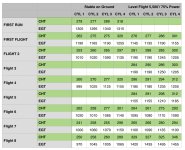Bsquared
Well Known Member
I am running a stock 390 and have been following the recommended break in.....long flights At WOT and 2500 rpm. At 6500 feet that gives me about 72% power..... well above the 65% recommended min. I am right at 20 hours and my CHTs and oil temps are good but I am still burning about a quart of oil (AeroShell 100) every 4 to 5 hours. Is this common? I have heard that it can take over 50 hrs to break in the 390. The belly is clean so not going out the crankcase vent.






